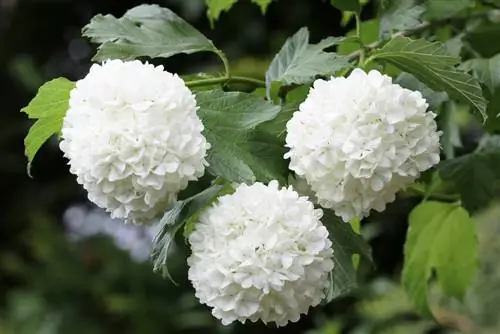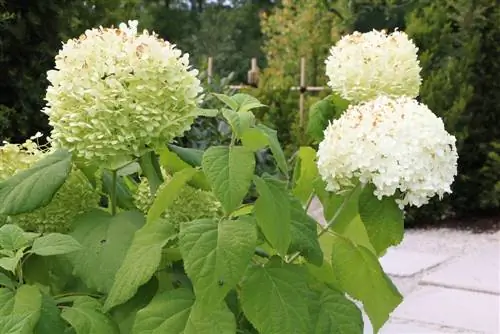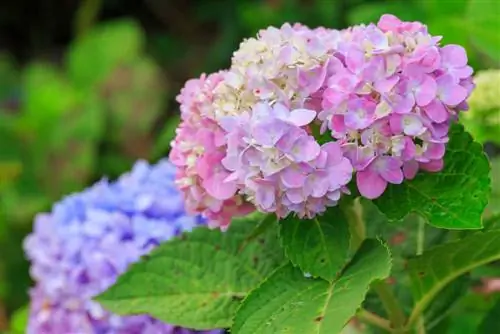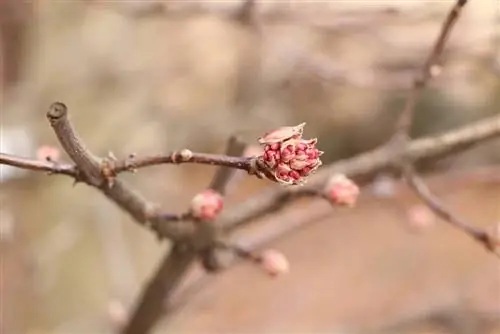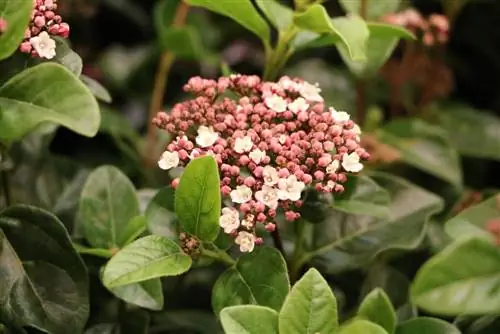- Author admin [email protected].
- Public 2023-12-17 03:39.
- Last modified 2025-01-24 12:45.
The common viburnum is a deciduous shrub with heights between 1.50 meters and 6 meters.
Special features
- green-brown bark
- later yellow to reddish-brown bark
- Leaves with green to red stems
- leaf edge serrated
The flowers of the common viburnum can look different depending on the variety. They appear according to the leaves at different times, which are between May and June in China and between May and August in Central Europe. The bush produces umbels of flowers that can have a diameter of 5-12 cm. In winter, the common viburnum bears bright red fruits, which are a berry-like drupe. In Central Europe the fruits ripen from August to November and in China between September and October. They change color from yellow to red.
Attention:
The common viburnum is a poisonous plant for humans in all parts!
Even if there is conflicting information regarding toxicity, the berries should be removed, especially in gardens where children use them. The most commonly planted variety is the common viburnum “Roseum,” also known as the garden viburnum. The flowers of this shrub can reach 8 cm in diameter and are white and turn pink as they fade. However, this viburnum bush does not produce beautiful red fruits in autumn.
Plants
The shrub can achieve a wide shape that can reach a height of up to 4 meters when fully grown. It reaches a width of 175-250 cm and grows at a rate of up to 40 cm per year. When it shows its beautiful white flower balls in May to June, it not only captivates with its appearance, but also with its light scent. Later, when the fruits are formed, the common viburnum displays bright red beads. The shrub's foliage also turns orange-red and impresses the viewer. Birds really like the berries of the bush and they are not poisonous to them. These attributes should be taken into account when planting the viburnum viburnum in the garden. It offers a beautiful view all year round, which you'll definitely want to enjoy from your living room window.
If you want to plant a new viburnum, you should use spring to do it. By next winter it can develop enough roots to be able to draw water from the earth. The place where it is to be planted should have enough space between neighboring plants. There should be at least half a meter of space between each plant. The common viburnum grows both in width and height. Even if you want to grow a viburnum hedge, sufficient distance from the next plant is important. It doesn't take long before the gaps in between are closed.
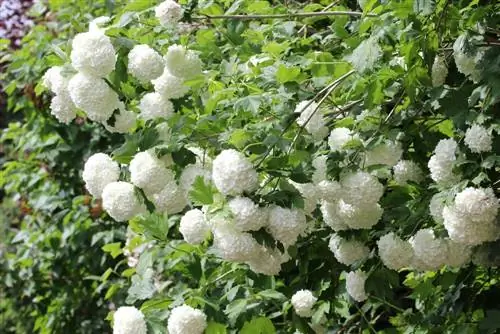
The common viburnum is also very popular as a container plant on the terrace. Planted in a sufficiently large pot, it is pleasing to the eye all year round. Here too, it is of course particularly important to ensure sufficient irrigation.
Tip:
The common snowball looks very good in a cottage garden or natural garden!
Location
The other name for the common snowball “water snowball” shows its preference for a moist location. It is not only planted as a shrub in the garden bed, but can also be cut into a hedge. The location should definitely be a sunny location. If there is no other way to arrange it, the common viburnum can also be placed in partial shade. However, if there is too much shade, it will lose all of its flowers and will not grow lushly. In addition, it cannot fully develop its resistance in the shade. The soil should be moist and can also have a clayey content.
The common viburnum needs sufficient water, especially in summer. Therefore, it should be included in the irrigation of the garden. Some gardeners are of the opinion that such a shrub does not need additional water, but this is a mistake. Especially if it has just been planted, the water requirement is slightly higher. Likewise, in sunny locations and in hot weather, a portion of water should be given in the evening. Beautiful varieties for the viburnum are:
- Viburnum opulus “Aureum”
- Virnum opulus “Compactum” (dwarf snowball)
- Viburnum opulus “Notcutts Variety” (dwarf tree)
- Viburnum X bodnantense (Winter Snowball)
- Viburnum x burkwoodii (Easter snowball)
Cutting
Whether it is in a pot in the garden or on the terrace, the common viburnum should also be cut. In late spring, when the flowers have withered and been removed, it can be cut back or thinned out. The best time for this is June. The old branches should then fall victim to the scissors, if possible before the new shoots are formed.
Care
In order to use another bush of the common viburnum in your garden or in a container, you don't have to buy a new one. Propagation can be done by cuttings in summer, which are rooted, or by cuttings orRoot runners can be reached. The common viburnum is easy to care for and apart from pruning it doesn't need to be pampered much. However, like other plants, it can become a victim of pests. Aphids are particularly keen to settle on it. Sometimes this can be so strong that flower formation is at risk. Without control with the appropriate means, not only the flowers could be destroyed, the foliage can also become crippled.
What you should know in brief
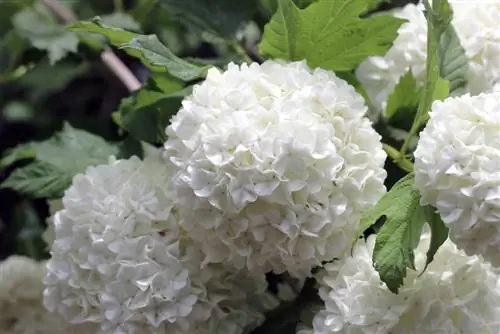
The common viburnum is probably one of the most popular flowering hedge plants that can be found in German gardens. Its scent is captivating and that is one of the reasons why it is often planted. The white flowers really look like snowballs, which is why the name is particularly apt. The flowers appear in May to June. Small red berries then form, which are even edible.
In many countries the berries are processed into jam and juice. Raw, crushed and sweetened with a little honey, they even help with colds. The fruits appear on the plant in August/September. Only ripe fruits are suitable for consumption. Unripe fruits, like the leaves and bark of the plant, contain toxic glycosides and viburnin.
- The common viburnum can be recognized by its maple leaf-like leaves. The woolly snowball has oval, finely serrated leaves that are also slightly hairy. Hence the name.
- The common viburnum prefers slightly moist clay soils, in contrast, the woolly viburnum prefers slightly drier, humus-rich soil.
- Sunny to partially shaded locations are ideal. The shrub is relatively easy to propagate using semi-lignified cuttings.
- Only the common viburnum bears red fruits. The berries of other foreign viburnum varieties tend to be black in color when ripe.
- Unripe berries cause vomiting and diarrhea, which often affects children who snack on the unripe fruits.
- The essence that can be obtained from the leaves and bark is used in homeopathy to treat menstrual problems.
- The branches of the viburnum are very flexible and pliable, making them ideal for braiding. This means that clippings can be used again during the craft season (autumn).
- The plant does not require any special care. It is very undemanding when planted in the right location.

